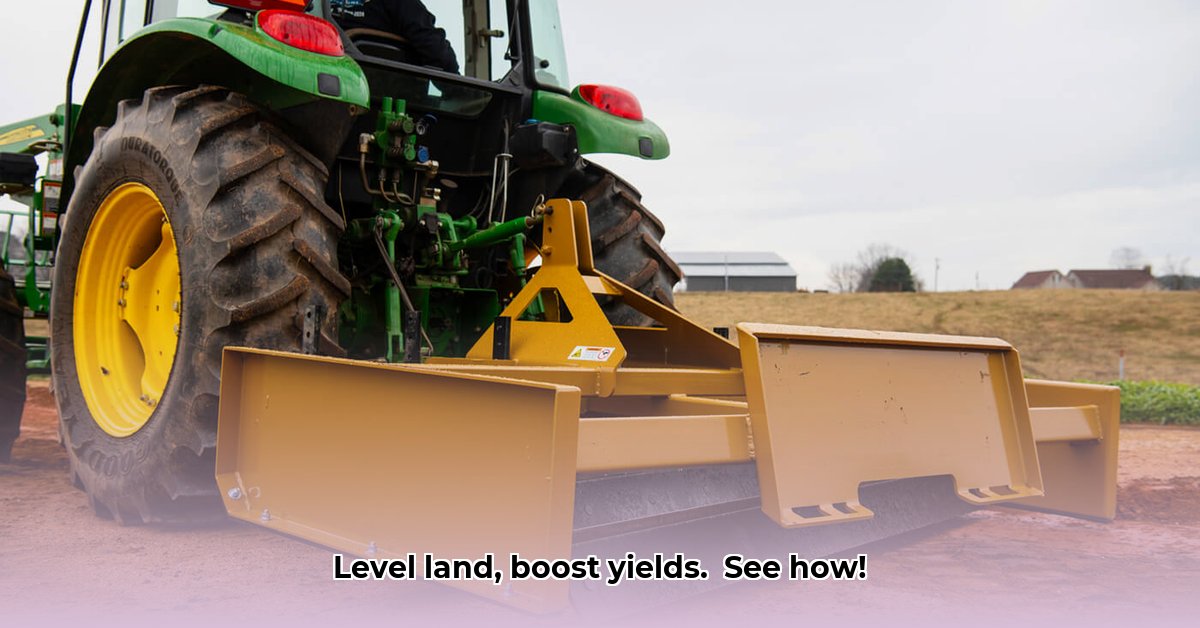
Land Levelers for Tractors: Level Up Your Farm and Boost Your Yields
Perfectly level fields are essential for maximizing crop yields and promoting sustainable farming practices. Uneven land leads to inefficient water and fertilizer use, resulting in lower yields and environmental impact. Tractor land levelers offer a solution, smoothing fields for optimal planting and growth. This guide provides practical advice on selecting, operating, and maintaining land levelers for improved efficiency and sustainability. For more information on soil aeration, check out this helpful resource: soil aerators.
Choosing the Right Land Leveler: Finding Your Perfect Match
Selecting the right land leveler is crucial for optimal performance and return on investment. Consider these key factors before making a purchase:
- Budget: Prices vary widely, from basic box scrapers to sophisticated laser-guided systems.
- Soil Type: Heavy clay requires different equipment than light, sandy soil.
- Farm Size: Larger operations may need larger, more powerful levelers.
- Tractor Horsepower: Ensure sufficient power to avoid strain and potential damage. Underpowering can lead to breakdowns and inefficient operation.
Types of Land Levelers
Several types of land levelers cater to different needs and budgets:
- Box Scrapers (Simple, Affordable): Ideal for smaller farms or smaller leveling projects. They are versatile and relatively inexpensive, making them a popular choice for budget-conscious farmers.
- Laser-Controlled Levelers (High Precision): These precision instruments use lasers for guidance, ensuring incredibly accurate leveling and maximizing efficiency. The higher initial cost is often offset by increased yield and reduced waste.
- Rippers (Heavy-Duty): Designed for extremely uneven terrain, breaking up compacted soil before leveling. Essential for challenging land preparation.
Ongoing research continually improves land leveler design and efficiency, leading to more sustainable and productive tools. Isn't it remarkable how innovation keeps pushing the boundaries of agricultural technology?
A Checklist to Guide Your Decision
Use this checklist to ensure your land leveler aligns with your farming operation's needs:
| Feature | Considerations |
|---|---|
| Size and Design | Match to field size, soil type, and desired maneuverability. |
| Tractor Compatibility | Ensure adequate horsepower and hydraulic capacity for safe and efficient operation. |
| Durability and Construction | Prioritize robust build quality and easy access to replacement parts. |
| Ease of Maintenance | Consider parts availability and ease of performing routine maintenance. |
| Initial & Ongoing Costs | Factor in purchase price, fuel consumption, and potential repair expenses. |
Operating Your Land Leveler: A Step-by-Step Guide
Safe and efficient operation is paramount. Follow these steps:
- Pre-Operation Inspection: Thoroughly inspect the land leveler and tractor, checking fluid levels, blade condition, and security of all attachments.
- Ground Preparation: Clear the field of debris, rocks, and obstacles to prevent damage and ensure smooth operation.
- The Leveling Process: Make multiple passes, slightly overlapping each to ensure even leveling. Adjust technique based on soil and terrain conditions. Remember, slow and steady wins the race!
- Post-Operation Maintenance: Clean, lubricate, and store the equipment properly to extend its lifespan and prevent damage.
Is it vital to keep a regular maintenance schedule for increased longevity and safety? Yes, regular maintenance significantly improves the overall lifespan of the equipment.
Sustainability and Land Levelers
Sustainable farming practices are increasingly important. Land levelers contribute by reducing water runoff, preventing soil erosion, and improving irrigation efficiency. Efficient leveling also minimizes water waste, contributing to responsible resource management.
Choosing durable, long-lasting equipment is a sustainable practice on its own, minimizing the need for frequent replacements and reducing waste. Exploring options made with recycled materials further enhances environmental friendliness.
Safety: Always Your Top Priority
Safety precautions are crucial. Always wear appropriate protective gear, operate at a safe speed, and be aware of your surroundings. Regular maintenance helps prevent unexpected breakdowns and reduces the risk of accidents. Is prioritizing safety a necessity or a mere suggestion? It's an absolute necessity, for the sake of the operator and for efficient operations.
Conclusion
Choosing the right land leveler is a significant investment. By considering your needs and following these guidelines, you can boost yields, reduce waste, and enhance sustainability. A well-maintained land leveler is a vital tool for efficient and responsible land management.